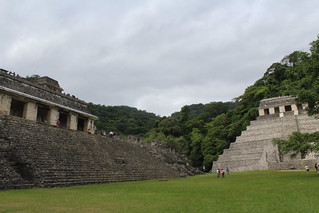 From the time we first began to visit Mayan ruins, Palenque has been on our must see list. While not a huge complex, it has the well-deserved reputation of allowing a close up look at buildings of a pleasing architectural style in various stages of restoration. But Palenque is not the easiest place to get to in Mexico so it’s taken us a while to make our first visit. But we’ve finally made it and are happy to post this report.
From the time we first began to visit Mayan ruins, Palenque has been on our must see list. While not a huge complex, it has the well-deserved reputation of allowing a close up look at buildings of a pleasing architectural style in various stages of restoration. But Palenque is not the easiest place to get to in Mexico so it’s taken us a while to make our first visit. But we’ve finally made it and are happy to post this report.
There are reasonably priced group tours to the ruins from the town center that depart each morning at 8:00 am that we had hoped to make on the morning of our arrival via overnight bus from Playa del Carmen but with our late arrival in town, we took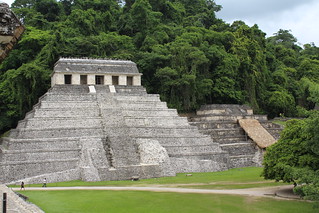 the time to have breakfast at the hotel before heading out to the ruins.
the time to have breakfast at the hotel before heading out to the ruins.
The UNESCO World Heritage archaeological site within the Parque Nacional Palenque is 6 km or about 3½ miles from the modern town of Palenque. There are regular runs by combis (shared mini-vans) for about $3 USD round trip but we decided to hire a cab for the ride and arranged with our driver to be there for our return.
About a mile from the ruins, you’ll stop to pay a general park admission price of less than $2 USD per person. At the 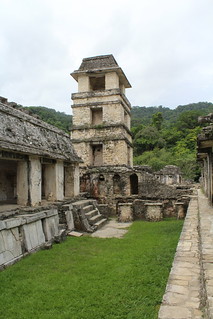 edge of the ruin site, you’ll pay an additional fee of about $3.50 USD to enter the area.
edge of the ruin site, you’ll pay an additional fee of about $3.50 USD to enter the area.
From that point you can tour the ruins on your own but we chose to hire an official English speaking site guide for roughly $65 USD. One word of caution; when we first met our guide, he quoted us a price of $980 MXN per person. When we politely pointed out that the guide fee should be per guide and not per visitor, he quickly backed off to the official park guide association rate. In fact, that fee should be good for a group of up to 7 visitors.
Once you reach the ruins, you’ll naturally be drawn to the large structures in the central area that are in various stages of restoration. On one side of the central courtyard, also referred to as the acropolis is the Palace, which was the residence of the royal family and high priests.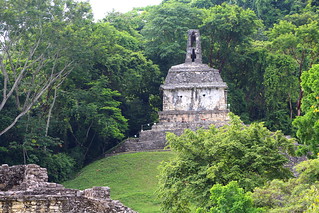
On an adjacent side of the courtyard is the Temple of the Inscriptions; the tallest structure in Palenque and a tomb for the Royals. Next to that is a smaller building that houses the tomb of Lady Sak K’uk’, the mother Pakal the Great who was instrumental in his taking power. Adjacent to that and across the old courtyard from the Palace there is a partially restored structure, which given its location on the central plaza, must have been an important building.
In fact, much of Palenque is unrestored. Looking in any direction from the central plaza will reveal not only some restored structures like the Temple of the Cross and the Temple of the Sun but also other ruins that appear to be little more than piles of stones and in some cases, small hills. While mu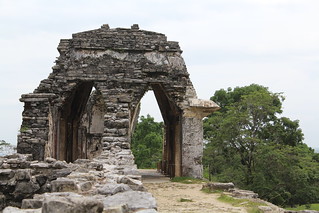 ch of the Palace was restored in the 1950’s, a significant portion of it still remains in a state of ruin.
ch of the Palace was restored in the 1950’s, a significant portion of it still remains in a state of ruin.
After years of seeing Corbel Arches at Mayan ruins, it was viewing the partially restored examples at the Palace in this photo when I finally grasped the concept of how they are constructed. Basically, the builder constructs side by side columns and as they near the top, each level of the column extends further and further towards the one beside it until the gap is completely bridged. Additional weight on top of the arch actually increases its stability.
Close examination of the Palace will reveal original paint and other decorations and a lovely central courtyard. It will also demonstrate some of the remarkable technology achieved by this early culture like running water including indoor toilets in the palace driven by an elaborate system of aqueducts from water sources located on higher grounds.
We made our way back to entry area and our taxi via a walk through the Jungle where we could see additional mounds reflecting unrestored structures and glorious flora.
